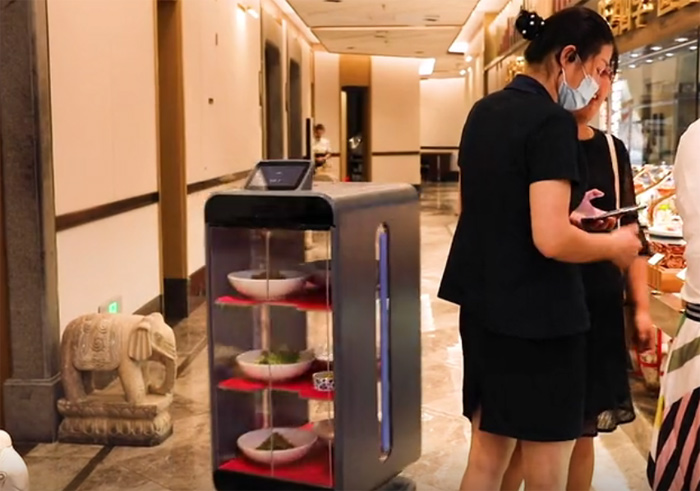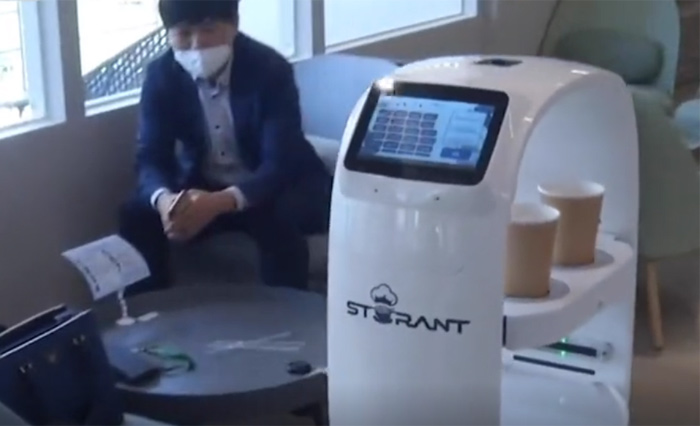因疫情需要,越来越多的机器人服务员在餐厅上岗。它们可以接单、准备食物和送餐,在提供无接触式服务的同时还可以增加餐厅人气。

腾讯视频截图
Customers at a fast-food chain in South Korea can avoid any interaction with a human server during the pandemic. No Brand Burger is using robots to take orders, prepare food and bring meals out to diners.
韩国快餐连锁店No Brand 汉堡店用机器人接单、准备食物和给顾客送餐,这样顾客就可以避免与人类服务员产生任何互动。
Customers order and pay via touchscreen, then their request is sent to the kitchen where a cooking machine heats up the buns and patties.
顾客通过触摸屏下单并支付,然后订单就会送到厨房,厨房里的烹饪机器会加热小圆面包和肉饼。
When it's ready, a robot 'waiter' brings out their takeout bag.
准备好后,机器人“服务员”会将外卖送过来。
Human workers add toppings to the burgers and wrap them up in takeout bags before passing them over to serving robots.
工作人员负责在汉堡上淋上浇头,将其用外卖袋包装好,然后“交给”机器人服务员。
Last month, takeout orders at No Brand accounted for 58 percent total sales, up from 42 percent in July, according to the chain's parent company, Shinsegae Food.
根据No Brand汉堡店所属的新世界集团食品部的数据,上个月No Brand的外卖订单占了总销量的58%,相比七月份的42%上升了。
After a recent second wave of coronavirus infections, restaurants in South Korea were only allowed to provide takeout and delivery after 9pm - a restriction that was only lifted Monday.
在近期暴发第二波新冠疫情后,韩国只允许餐厅在晚上9点后提供外卖和送货服务,这一限制令刚刚于9月14日解除。

腾讯视频截图
Other eateries in Asia have started employing robot servers during the pandemic.
亚洲的其他一些餐厅已经开始在疫情期间启用机器人服务员。
In South Korea, the Italian restaurant chain Mad for Garlic is using serving robots even for sit-down customers.
在韩国,大蒜主题意式餐厅甚至让机器人为堂食顾客服务。
Using 3D space mapping and other technology, the electronic 'waiter,' known as Aglio Kim, navigates between tables with up to five orders.
名为阿利奥·金的机器人服务员运用三维空间映射等技术在餐桌之间穿梭,一次最多可以接5份订单。
Mad for Garlic manager Lee Young-ho said kids especially like the robots, which can carry up to 66lbs in their trays.
大蒜餐厅经理李英浩说,孩子们特别喜欢这些机器人,它们的盘子里可盛放重达66磅(约30千克)的食物。
Initially South Korea had been doing well against the virus, but in August, the number of reported infections nearly doubled, from 56 to 103, in just two days. It reached a peak of 441 cases on August 26 before ticking back down to at least 100 new infections per day.
最初韩国的抗疫局面一直不错,但八月份报告的新增病例数几乎翻了一番,两天内就从56例增至103例。8月26日韩国新增确诊病例达到了441例的高峰,之后又回落到每日新增至少100例的水平。
That month, the health ministry banned large gatherings and shuttered nightclubs, churches and beaches to turn the tide.
为了扭转局势,八月份韩国卫生部禁止了大型聚会,关闭了夜总会、教堂和海滩。
To date, the country of 50 million has had 22,504 reported cases of COVID-19 and 367 deaths, 42 of which were in Seoul.
到目前为止,拥有5000万人口的韩国新冠肺炎确诊病例累计达22504例,死亡367例,其中有42例在首尔。







